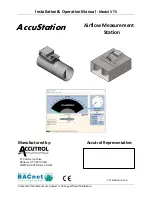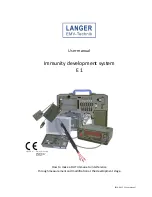
For more information visit: www.eaton.com
IB140012EN
Instructional Booklet
Page
4
Effective: March 2021
Operation and Maintenance Manual,
Automatic Transfer Switch Controller, ATC-900
1.4.2 Standard and Optional Features
A variety of programmable features are available to meet a wide
array of application requirements. Individual features or feature
combinations provide the information required to tailor switches to
individual needs.
Unlike earlier controllers, the ATC-900 comes with standard fea-
tures that are ready to use, with the exception of Closed Transi-
tion, Current metering, and Ethernet. Another advancement is that
there are four (4) standard inputs and four (4) standard outputs
that the operator can easily program by choosing from a wide
array of predefined functions. Additional inputs and outputs can
be added in groups of four (4) up to sixteen (16) for a maximum of
twenty (20) in total. The inputs are DC wetted (24 Volts at 10
ma) connections for various functional inputs.
1.5 Glossary of Terms and Features
Available
A source is defined as available when it is within its undervoltage/
overvoltage/underfrequency/overfrequency/unbalance(if applica-
ble) setpoint ranges for the nominal voltage and frequency setting.
Unavailable
A source is defined as failed when it is outside of its undervoltage/
overvoltage/underfrequency/overfrequency/unbalance (if applica-
ble) setpoint ranges for the nominal voltage and frequency setting.
Normal Source
The Normal Source is defined as the source that is preferred. The
Preferred Source setting allows the operator to select Source 1,
Source 2 or NONE as the Preferred Source. If NONE is chosen, the
Preferred Source or the Normal Source will be the source that is
presently attached to the load. The default is set as being Source
1 as the Preferred and Normal Source.
Emergency Source
The Emergency Source is defined as the source that is not pre-
ferred. If NONE is chosen for the Preferred Source setting, the
Emergency Source will be the source that is presently not
attached to the load. Therefore, in this condition after a transfer,
the Normal and Emergency Sources will switch between Source 1
and 2.
1.5.1 Features
The ATC-900 has many features that are available to the user.
These features are standard and are available depending on the
type of transfer switch used (i.e. Contactor, Power Frame Switch/
Breaker, or Molded Case Switch/Breaker, 2 or 3 position). Appen-
dix A has a list of all of the features including any acronyms used
along with a brief description. The feature numbers corresponds
to the internal codes and some of these numbers may be on the
product drawings. See Table 8 "ATC-900 Features" for a compact
list of features, including a full list of available I/O. Consult
Appendix B for I/O descriptions. For some transfer switch configu-
rations, standard input(s) and/or standard output(s) will be fixed at
the factory to support system functionality and will not be pro-
grammable in the field. An example of this is Service Entrance;
which requires Go To Neutral to be a fixed input. The programma-
ble I/Os are covered in Section 5.
The only item that is optional for the transfer switch is the closed
transition optional feature. The closed transition operation is cov-
ered in section 1.5.3
The switch type also dictates what can be programmed. For
example, a two position contactor switch cannot have feature
TDN (Time Delay Neutral), as it has no neutral position available.
A motor MCS/MCCB type transfer switch with motor operator
cannot have closed transition as the switching mechanism is not
fast enough and will not meet the time line.
1.5.2 In-Phase Operation
The In-Phase operation of an Automatic Transfer Switch is an
open type transfer. It will allow a transfer between two available
sources if the phase angle has a difference of five degrees or less.
See section 1.5.4. Appendix A (32C, 32D, 32F) shows detailed
descriptions of the different scenarios that can be performed using
In-Phase.
As shown in the feature list of Appendix A for In-Phase, there are
three scenarios for In-Phase:
32C= In-Phase default to Load Voltage Decay
32D= In-Phase default to Time Delay Neutral
32F= In-Phase
The user setpoints for In-phase transition are similar to this:
•
Disabled (In-Phase not used)
•
Alarm on Synchronization Fail (Will not switch and will show
an alarm)
•
Fallback to Open on Synchronization Fail (To TDN or LVD)
For example, with the setpoint at Fallback, using a two position
contactor, the switch will transfer, if no synchronisation occurs,
to the other source. The three position will allow the use of TDN
or Load Voltage Decay.
1.5.3 Closed Transition Operation
Several Options for Closed Transition
Once an ATS is in the field, other uses or changes may occur that
could require changes from the original requirements. One area is
the closed transition type switches. An application may initially
require that only a closed transition should be used and if it does
not synchronize because of maybe frequency, then the switch will
not switch to the other source and will show an alarm signalling
this issue. If the requirements now have change, for example, and
the switch must now transfer using open transition if closed does
not occur; instead of sending the controller back to the factory for
reprogramming, one can easily change the user setpoints to
accomplish any scenario. One may go from closed transition
directly to Time Delay Neutral for example. All options are avail-
able to the user.
If closed transition is available on the switch, the user will receive
47 D and all of the other options 47 C, E, F, G which can be
changed by the setpoints to disable or enable the functions (see
below). Screen 3 of 3 in the System Setup menu (See section
3.4.1) is where the user will set the transition types of the switch.
If the switch can perform closed transition the user will set up the
setpoints depending on the scenario required as shown below.
Closed Transition to Alarm (47D) or by changing the setpoints,
Closed Transition > In-Phase > TDN
Closed Transition > In-Phase > LVD
Closed Transition > TDN
Closed Transition > LVD
The user can disable closed transition and just use the following:
In-Phase > TDN
In-Phase > LVD
NOTICE
WITH RESPECT TO THEIR USE IN THIS DOCUMENT AND AS THEY
RELATE TO AUTOMATIC TRANSFER SWITCH OPERATION, THE FOL-
LOWING WORDS OR PHRASES ARE DEFINED.





































